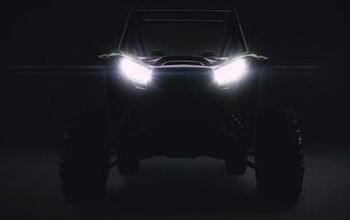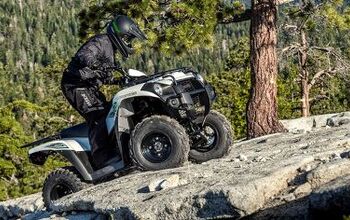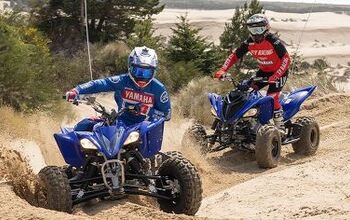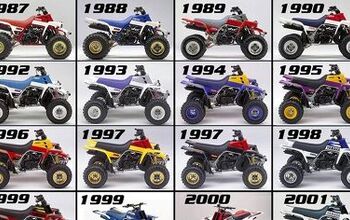2011 Kawasaki KFX450R Review
Several years ago seven ATV manufacturers had 450cc class machines on the market. With the unexpected economic slow down, many ATV manufacturers were left holding the bag and are still trying to move those models. Kawasaki is one of the remaining three offering current model (2011) 450cc sport ATVs and Team Green deserves recognition for that. The KFX remains mostly unchanged over the past five years, minus only a few updates including improved water resistance for the wiring harness. We know the machine is reliable and performs well, so we can live without any major updates. We are simply happy that Kawasaki is helping keep the 450cc class alive!
Last year we put Kawasaki’s 2010 KFX450R through its paces at the Badlands Off-Road Park in Attica, Ind. and were impressed with its prowess for both track and trail. Unfortunately we didn’t get much track time on the machine due to the monsoon that went through on our day of testing and the day prior. This year we decided to see how the KFX would perform in a real track test so we loaded up our brand new 2011 test unit and headed to Horseshoe Bend MX located in Walton, Ky. The facility features two motocross tracks with lots of elevation changes and jumps of various sizes. The facility also has a sweet rail loop and an extremely rad BMX track.
After spending some time riding trails on the KFX450R, we figured it was time to take this beast to the track!
About the KFX450R
Powering the KFX is a 449cc, liquid cooled, four-stroke, fuel-injected engine.
At the heart of the KFX is a 449cc liquid cooled, four-stroke engine that was originally borrowed from Kawasaki’s 2008 KX450F dirt bike then slightly reconfigured to perform more ideally in an ATV chassis. The four valve double overhead cam features titanium valves and aluminum valve spring trainers keeping the valve train light for more efficient and reliable operation at high RPMs. Its lightweight forged piston features a compression ratio of 12-1, which requires the use of premium pump gas or better. The engine is brought to life by push button electric starting. Kawasaki offers a kick-start conversion kit for die hard racers, but we will stick with the ease of left thumb starts.
Digital fuel injection is Kawasaki’s fuel delivery method of choice for the KFX. This allows the machine to start more easily in cold weather and operate more efficiently at higher elevations. The 32-bit fuel injection system features a 42mm throttle body. The system measures coolant temperature, air intake temperature, air intake pressure, engine speed and throttle position then automatically delivers the right amount of air and fuel. Being an open loop system, meaning there is no sensor measuring the exhaust gasses, the system is unable to compensate for motor modifications. Switching out the KFX’s intake and exhaust for something from the aftermarket will require the use of an aftermarket fuel management system. This is normal on all of today’s fuel injected 450s. One unique feature on the machines fuel injection system is its choke/idle speed-adjuster knob. It is located on the side of the throttle body and isn’t particularly easy to find the first time you search for it. Using it on colder days keeps starting nice and easy.
The KFX450R features a five speed forward transmission. It is also the only Japanese produced 450 on the market with reverse. Some track riders think it’s not worth the extra few pounds to have reverse. Of course once they get hung up on a berm overshooting a turn their feelings may change.
The engine is housed in one of the gnarliest looking frames on the market. Kawasaki designed its beefy aluminum frame and removable sub-frame, to be both light and highly rigid for responsive handling and to provide maximum traction in corners due to minimal frame flex. The front of the frame features a single box-tube lower frame rail. This mounts the lower A-arms as closely together as possible, allowing for the use of longer arms. This results in a front end with less bump steer. This chassis has proven to be one of the strongest in the 450cc class. Take it from us you don’t want to have to tear down your entire machine due to a cracked frame.
Though other machines feature longer suspension travel the KFX450R makes up for it with maximum adjustability.
Bolted to the frame are gull wing style A-arms up front which are paired with piggyback reservoir-equipped KYB shocks delivering 8.5 inches of suspension travel. Many of the currently produced and leftover machines on the market have around an inch more travel up front, except the Honda which has just a hair less. The front shocks feature progressively wound springs providing a dual rate spring setup. The KYB shocks are extremely adjustable (preload, compression, and rebound), which helps make up for their mild shortcoming.
Out back Kawasaki has installed a beautifully constructed cast aluminum swingarm. The swingarm is designed with curved lines and rounded edges to reduce flex and unwanted fatigue – the result is a light yet very strong component. The swingarm also features a concentric chain adjustment system with four pinch bolts, making chain adjustments a breeze.
Along with the swingarm the rear suspension consists of a linkage and KYB shock. The rear shock controls 10 full inches of suspension travel and features preload, high and low speed compression and rebound adjustment.
Measuring 46.1 inches wide, the KFX450R is very trail friendly. However many design details work together to make it track capable for the recreational rider or casual racer in stock trim. First off the KFX sits low and squatted. The engine is mounted low in the frame to help provide a low center of gravity. The coolant is mounted low in the front of the chassis and the battery was even moved down low in front of the engine and its seat height is also impressively low at 30.9 inches.
Stopping power comes courtesy of hydraulic disc brakes front and rear. Up front dual piston calipers slow 183mm discs. The back end features a single piston caliper that binds a lightweight pedal-style rotor, which helps reduce unsprung weight and is said to help keep the rear brake pads cleaner and working more efficiently.
The handlebar and levers are of very high quality. Our only complaint was the parking brake lever getting in the way of clutch adjustment.
Acceleration and braking forces are transferred to the ground by 20×7-10 inch front and 20×10-9 inch rear Dunlop tires. These are mounted on high quality aluminum rims. The rear rims feature reinforcing rings providing superior strength and further enhance rigidity.
In the cockpit the KFX comes pretty well equipped, including a top-notch Renthal Fatbar handlebar. The mounting hardware can be reversed, allowing you to move the handlebar forward or back a bit. The levers are very nice quality and the front brake lever has an adjustable reach. The clutch lever features a quick adjust system, which can be a big help when you need to adjust your clutch in the middle of a race. We found the parking brake lever gets in the way of the clutch adjustment barrel a bit, but you can work around it or if you are a racer, simply remove the parking brake.
The seat cover features a grippy material on top and smooth material on the sides. This allows you to stay planted on the seat under acceleration or braking while allowing you to move around more freely while standing and gripping the KFX with the sides of your knees. As for the bodywork, it features removable front and rear fender extensions – a nice touch.
Along with its 46.1-inch width and low 30.9-inch seat height, the KFX450 has a compact wheelbase of 49.4 inches; it has a fuel capacity of 2.6 gallons and a claimed wet weight of 392.5 pounds.
Track Time
We arrived at Horseshoe Bend MX one a beautiful 60-degree sunny Saturday morning to put the KFX through its paces. It fires right up without the need to touch the choke button. Starts are pretty easy as long as you don’t push the throttle, as the machine will not start with the throttle depressed. Once started the engine springs to life with a quiet roar thanks to its restrictive yet neighbor-friendly exhaust. We found the engine to emit very little internal noise and immediately became comfortable with the sound of the engine.
It’s time to leave the woods behind and see what this machine can do on a motocross track.
Slipping the clutch out for the first time we found its action light and smooth. Cruising around getting the feeling for the tracks we discovered the machine’s good low-end torque. The KFX puts out as good or better low end power then the other fuel-injected machines on the market. This is a real plus in case you find yourself exiting a turn a gear high or have to pull a steep uphill right out of a corner. Although this is a track test this is a big plus for trail riders and woods racers.
The KFX’s low-end grunt makes itself known while exiting corners or pulling a steep climb.
You don’t want to get carried away lugging it, this is a 450 not a 700. If you want to take full advantage of the engine it takes a few more RPMs. As our speeds increased we were greeted by a seamless surge of midrange power and this is where the Kawi gets most of its work accomplished. As you reach the upper midrange the KFX reaches its sweet spot in the rev range. The strong midrange made it a lot of fun to hammer up Horseshoe’s larger climbs.
Power begins to taper off as you reach the upper RPMs. As the engine peaks in the top of the midrange you grab the next gear and let her rip. While the KFX doesn’t quite have the top end of the Can-Am DS 450 or Yamaha YFZ450R, it has considerably stronger bottom end then a stock DS and not constantly revving your engine to redline will surely help it last. Its broad easy to use power made it easy to get around the motocross track. Its good low end and strong midrange make this machine easier to ride for novice to intermediate level 450 pilots and it is only a few bolt-on parts away from being a 50-horsepower motor.
Shifting on the KFX is very smooth as is its clutch action. The gears seem well spaced helping make sure that power is always available. Although we were playing the role of motocrossers who don’t need reverse, it sure came in handy maneuvering in the pits. In our opinion the KFX has the smoothest working reverse system of any sport ATV.
It may not have the 50-inch width of motocross-specific quads, but the KFX still offers very stable handling thanks to its low center of gravity.
Despite its narrower width, handling proved to be super stable. It may not be 50 inches wide but its low center of gravity, squatted stance and low seat height all lend to the KFX having little body roll. Pinning the throttle out of turns you can really feel how rigid the chassis is. This really adds to the chassis having a very responsive feeling.
Steering is nice and light but at times the KFX can feel just a bit too responsive. The front end can feel a bit darty in stock trim. This is due to the fact that the arms have virtually no caster. The less caster an ATV has the faster it turns. This becomes compounded while braking hard through bumps. As the front suspension compressed things happen even faster. At this point small inputs from the handlebar have a more dramatic effect and to make things more difficult the front tires don’t hook up especially well, resulting in the feeling like the front end is all over the place.
Responsive handling is a great thing, the KFX just needs a little setup to lose the nervous feeling and take advantage of its handling qualities. First, we reset the toe in to parallel. Stock it was toed out nearly a half inch. Next we increased front preload from 1/8 of an inch to 1/2 and we backed the rebound out a few clicks to help keep the front end riding higher under heavy braking. These changes alone helped quite a bit. If you are skilled enough to purchase a 450, you should be skilled enough to tune it to extract the most available performance from it.
In stock trim the KFX lands well from jumps but felt a bit harsh through braking and acceleration bumps. We added some preload to the rear shock and sped up the rebound a few clicks to help keep the rear suspension from pacing. By the time we finished messing with our suspension the ride had improved dramatically and we hadn’t spent a dime on aftermarket suspension. With our suspension dialed in the machine still did a nice job of landing from jumps and did a much better job of isolating the rider from deep acceleration and braking bumps. The KFX shocks are extremely adjustable so take advantage of it!
Feel free to launch this rocket at your leisure as it handles itself wonderfully on landings.
We aren’t particularly thrilled with the stock tire choice. They don’t hook up well, especially up front and they have a tendency to bounce through rough sections. It contributes to the front-end feeling nervous and makes the suspension difficult to dial in. We tried a set of Kenda Kutter GNCC tires to see what difference they might make. While they weren’t motocross tires they are lower profile than stock, don’t bounce like the stock tires and offer much better front-end control. Being the same size as stock meant they wouldn’t require us to change our machine’s gearing. They made a huge difference in directional control mad made the overall handling much better.
We found the KFX to be very well balanced and it flies straight and true after takeoff.
While some shorter wheelbase sport machines can tend to get light in the nose launching off of jumps, the KFX flies straight and true thanks to good weight balance and a low center of gravity. Leaving the lip of jumps the KFX sets you up for success unless you make a big mistake with your body positioning. If you do get out of shape in the air the KFX feels very light so mid-flight corrections are easy for skilled pilots.
The KFX450’s cockpit is compact without feeling too cramped. If you are near six-feet tall switching the handlebar clamps around and removing the front fender extensions affords you more space. More vertically challenged riders should really like the stock layout.
We found the seat to be a bit firm, which on trail rides can be fatiguing. On the track, however, it makes the KFX easier to move around on. For a motocross machine we may leave the seat foam alone. We like the stock seat cover, which works as advertised providing good traction for sitting and the ability to move around while standing. One of our test riders last year felt the pegs were a bit too high. If you are taller and share this feeling, it can easily be fixed with a set of aftermarket nerf bars. The Kawasaki’s controls are superb. The Renthal handlebar is of very high quality, the levers feel great and the throttle shape and action are comfy and light.
Overall the KFX450R is an excellent trail/motocross crossover with the potential to be a winner if you want to race.
At $8,099 the KFX450 costs $500 less then the Yamaha YFZ450R (or YFZ450X) and $300 more then the base model Can-Am DS 450. While Kawasaki may not have made any major updates to the machine over the past four years, for a 450cc class machine it has proven to be reliable and has loads of hop-up potential. If we were looking for a trail-width machine we could occasionally race motocross on or simply have a great time on the track the KFX is a good buy and a great option.
Related Reading
More by ATV.com Staff



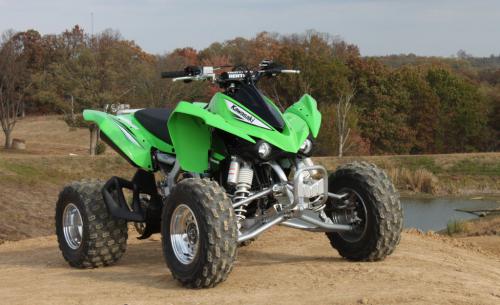


















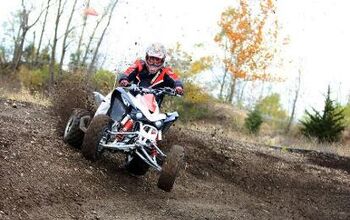
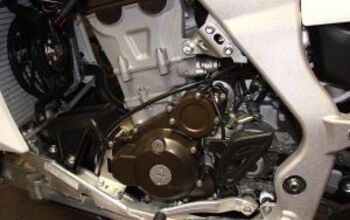
![2011 Kawasaki KFX450R Project – Woods Warrior [Video]](https://cdn-fastly.atv.com/media/2022/10/24/8776971/2011-kawasaki-kfx450r-project-woods-warrior-video.jpg?size=350x220)

![2011 Yamaha Raptor 700R & YFZ450R Special Edition Review [Video]](https://cdn-fastly.atv.com/media/2022/10/24/8748167/2011-yamaha-raptor-700r-yfz450r-special-edition-review-video.jpg?size=350x220)


